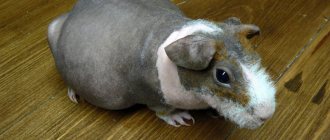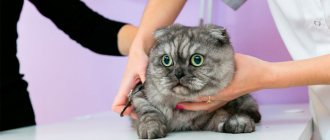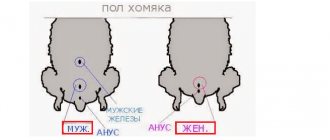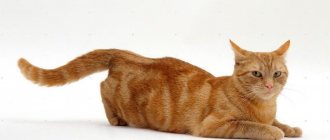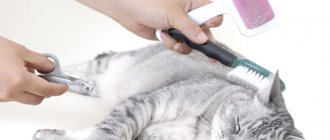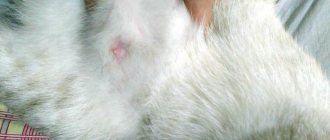Pregnancy
Fluffy beauties go pot-bellied for about sixty days, but this is an average period. It happens that kittens appear on the fifty-eighth or seventy-first day. The beginning of this period is the day of mating plus thirty-six hours. Take care of your pet during this period, follow the following rules:
- do not let her jump from a great height, she may fall and get hurt, in addition, such situations are fraught with miscarriage,
- try to isolate her from other pets and children so that she is not picked up and injured again,
- make sure there are no drafts in the house, protect her from stress,
- create a high-calorie menu,
- do not give antibiotics and other medications without the recommendation of a veterinarian,
- do not use anthelmintics or painkillers.
If you follow these recommendations, at the appointed time your pet will bring you several fluffy balls that will be healthy and strong. It is quite difficult to immediately determine what she suffered; there are no tests for this. But there are signs that can indirectly indicate whether conception has occurred or not. This:
- weakness, possible nausea,
- decreased activity, lethargy,
- change in appetite in any direction,
- pink nipples after twenty-one days,
- change of taste,
- changes in habits, most often the animal becomes more affectionate and intrusive,
- increased gas exchange,
- weight gain,
- more frequent and deeper breathing (at the end of the period).
An ultrasound will help you understand whether you can expect a replenishment in the near future, already from the second week after the act. X-rays will show the result only after forty days, this will help identify pathologies. The veterinarian will tell you the result on the twentieth day, but later you can no longer palpate until the forty-ninth day, because there will be fluid in the uterus. The abdomen will appear in the fifth or sixth week, and in the seventh the babies will begin to move.
Feeding your pet should become more nutritious and of better quality. Buy special super-premium food and increase the feeding rate by fifty percent from the third week, and from the eighth week you should not overfeed it. Giving food three to five times a day
It is important that the expectant mother receives the necessary supply of fat, otherwise she may not have milk. Make sure you are not obese - in this case, childbirth can be difficult and miscarriages may occur.
How to organize a feeding schedule
It is impossible to give any direct recommendations or specific standards. After all, only the number of offspring and the general condition of the woman in labor determine energy expenditure and the need for its replenishment. Please note that each kitten is attached to the nipple every 1.5–2 hours, so the animal should be fed upon its first request.
The number of feedings should definitely be increased during this period and depends entirely on the following indicators:
- the weight of the woman in labor;
- number of kittens born.
Requirements for food:
- The cat should not be allowed to experience hunger or thirst during this period. Food must be provided to her upon request.
- There should be only as much food as the animal can eat. Any remaining uneaten food should be removed immediately.
- Food is prepared exclusively from fresh natural products.
- Food is given to the cat often and in small portions.
You should pay attention to which foods are prohibited for consumption during this period:
- raw meat;
- potatoes (starch is not digested by the cat’s gastrointestinal tract);
- sugar, salt, spices;
- sour cream and cream (due to high fat content);
- sausages;
- River fish.
Pregnancy and childbirth of a cat
Estrus and mating time for cats occurs in February, March and the end of August. So this can happen twice a year. However, if the cat is not fertilized during estrus, estrus may repeat after 2–3 weeks.
Cats become sexually mature much earlier than males; this happens at 6–8 months of age (in males, sexual maturity occurs at 8–10 months). Unlike cats, whose desire to mate is constant, a cat is limited in time. She is in heat for about a week. The ability to reproduce offspring remains in females until old age, at least up to 8 years.
The onset of estrus is accompanied by changes in the cat's behavior. The animal meows loudly, the meowing turns into a piercing loud howl and squeal. The cat can roll on the floor, arch, its movements resemble those of a snake. She rubs her head and muzzle on the floor.
A cat and a male cat ready to mate recognize each other by smell a few days before the onset of estrus. During cat weddings, along with the urine, a special substance is released from the anus of cats and cats - a secret, it has a strong specific smell. They find each other by this smell.
Fertilization of a cat occurs in three stages - preparation of the egg, entry of sperm into the cat's body and penetration of sperm into the egg.
Each fetus in a cat is contained in its own amniotic sac. After a month of pregnancy, the embryos reach the size of a pigeon egg, and by the 45th - 47th day their length is 5 - 8 centimeters. The entire pregnancy period lasts 58–65 days. After which childbirth occurs. As a rule, several kittens are born, from two to four.
General information about the duration of gestation
On average, the question “how long does a cat stay pregnant?” The most frequently heard answer is 2 months. However, this is a rather loose concept - some individuals barely carry their offspring to term for up to 60 days, and for some the process can last up to 70.
According to general estimates, the minimum gestation period for cats is from 56 to 60 days, the maximum normal is considered to be 71 days (some sources give 72 days). These are periods when the birth of viable offspring is allowed. Most often - 64-67 days (roughly rounded, it comes out to 9 weeks).
The entire “pregnant” period is conventionally divided into 3 phases of development, each of which on average includes 3 weeks.
1 phase
This period lasts from the moment of expected conception to 21 days. During this period, eggs are fertilized and embryos develop. By the 15th day, the embryo already becomes up to 1 cm in size, by the 18th day the paws appear, and by the end of the period the internal organs are already formed. It is in this phase that active pinking of the nipples is observed.
2 phase
During this period (from 22 to 42 days), the brain, skeletal structure, muscles and endocrine system are actively formed and developed. From this point on, the kittens are called fetuses, taking on the classic feline appearance with a clearly defined muzzle and genitals. Only after a month of pregnancy the cat’s belly begins to grow a little.
3 phase
On days 43-63 from the moment of conception, kittens, growing to 8-10 cm, acquire a tail and acquire a coat with a certain color. By the middle of the period, their size reaches 13 cm, by the 57th day they are already fully formed and developed babies who are ready to be born at any moment. The maximum size of a newborn depends on the constitution of its parents.
There are exceptions to all rules. The duration may vary depending on many factors:
- offspring of purebred individuals born before 60 days are most often non-viable;
- cats with a slender constitution (subtle) usually never go pregnant longer than 65 days (on average it is 60-65 days), and fat and well-fed ones usually carry a pregnancy and the period can reach 70-72 days;
- primiparous cats, especially those who become pregnant during their first heat before the age of 1 year, in most cases give birth earlier than the expected average period (up to 60 days). Kittens are not always born viable and are often weak and small. That is why experienced breeders do not recommend mating a cat to produce offspring in the first heat and under the age of one year;
- primiparous middle-aged cats bear their offspring somewhat longer than their female peers who have given birth;
- yard outbred cats bear less fruit than domestic and special breed cats. Sometimes healthy babies are born on the 55th day - this indicates better endurance and higher adaptability of street individuals compared to domestic ones;
- in a fold cat (British, Scottish), kittens are gestated for an average of 63-67 days, but almost never less than 60 days;
- cases of nursing up to 75 days have been recorded. The course of the entire period was without complications, and the newborns were all alive and well. The reasons for such a long but safe gestation are still a mystery to veterinarians;
- Pregnancy of the Maine Coon breed is usually longer than that of other breeds - up to 68 days or 9 full weeks + preparation for the birth of the cat herself;
- long-haired cats stay pregnant longer (up to 70 days) than smooth-haired or completely hairless cats (around 65 days);
- the fewer fruits there are in the litter, the longer the cat can go pregnant and, conversely, the more, the faster and more often the birth will occur before the due date;
- weather conditions affect the onset of labor - sudden changes in temperature and environmental humidity can suddenly trigger premature birth;
- The pregnancy of a Scottish cat is usually shorter than that of a British cat, in which the pregnancy period can sometimes increase to 70-72 days. Therefore, there is no clear answer to the questions of how long pregnancy lasts in a Scottish cat or how long pregnancy lasts in a British cat - variations in duration are present here too.
Recommended Products
The diet largely depends on age and personal eating preferences. But regardless of this, a Scottish woman should consume the following types of foods.
Squirrels. They should be an essential component of nutrition, as they ensure the development of all types of tissues and muscles. Proteins of plant and animal origin must be present in the diet. It is necessary to give your favorite lop dog lean turkey, beef or chicken every day.
Fermented milk products such as kefir, cottage cheese, fermented baked milk and yogurt improve digestion and provide the body with calcium. It is an important component in the formation and strengthening of the skeletal system, teeth and claws.
Such products can be given in small quantities, and preferably low-fat or with a small percentage of fat.
Vegetables. Almost all types of vegetables will be well digested and absorbed in the pet’s body. The exception is white cabbage, which causes fermentation and stagnation in the stomach.
Vegetables should only be served boiled. They can also be grated and added to meat.
Cereals. Oatmeal is best. It improves digestion and stimulates intestinal function. Rice can cause constipation. Therefore, it is better to focus on the preferences of the cat itself.
Fish. During pregnancy, it is better to exclude it from the diet. But you can give small amounts of salmon, trout, mackerel or sardine meat, which contains fat-soluble vitamins.
If a Scottish woman prefers to eat ready-made food, then the best of them will be premium or super-premium class, created specifically for pregnant women.
Cheap food will not do any good. Due to the insufficient content of vitamins and minerals in it, her health may deteriorate.
The influence of diet on pregnancy
Cat pregnancy is an important period in the life of an animal, characterized by increased energy costs for the formation of future offspring. Over the course of 9 weeks, the animal’s body experiences an urgent need for additional nutrients.
The mother's body especially needs proteins. From protein structures in her womb, embryos are formed, and in later stages of pregnancy, the growth and development of fetuses occurs. Therefore, a pregnant cat’s diet should contain at least 35% protein.
Particular attention should be paid to the completeness of proteins. Protein deficiency can cause weight loss, abortions, miscarriages, and poor development of kittens.
Cats need a special amino acid – taurine. The need for it increases sharply in pregnant females. Microelement deficiency can cause miscarriages and the development of fetal pathology.
Cat food with taurine
In the first 2 - 3 weeks of pregnancy, the total amount of food should be increased by 10%. During this period, the animal needs nutrients and energy for hormonal changes and the formation of embryos.
From the 4th to the 7th week of pregnancy, intensive growth and development of the fetus occurs in the womb. This period is characterized by increased energy costs and requires an increase in the volume of feed consumed by 50 - 55%. The cat should receive boiled beef, turkey, and chicken. It’s good to add vegetables to them (zucchini, carrots, cabbage, beets). It is better to give low-fat fish every other day. Among cereals, it is better to give preference to buckwheat, rice, and oatmeal. It is useful to give a pregnant cat egg yolk and quail eggs.
2 - 3 weeks before giving birth, the cat itself begins to consume less food, and 2 - 3 days before giving birth it may completely lose its appetite. Therefore, during this period, the amount of feed should be reduced to the usual amount.
If the animal was fed ready-made dry formulas before pregnancy, then after mating it should be gradually transferred to specialized premium and super-premium dry food. Such mixtures are developed by well-known manufacturers taking into account the physiological needs of the expectant mother; they contain complete proteins and essential amino acids, including taurine.
Many manufacturers include special antioxidants and biologically active complexes in food for pregnant cats that help regulate hormonal levels and the functional state of the reproductive system of a pregnant female.
Signs of pregnancy
Unfortunately, science has not yet come up with pregnancy tests for animals. And an ultrasound will help determine the due date only after a couple of weeks. The duration of pregnancy of a Scottish Fold cat and future births can be determined at home. But first, let’s answer the question: how long does a pregnant Scottish cat walk?
The average gestation period for kittens is 60-62 days. Of course, in real life there may be slight deviations of a few days. In addition, it is not a fact that after the first mating the animal will become pregnant. Several meetings may be required. One way or another, the first signs of pregnancy can only be determined after 21 days after a successful mating.
ATTENTION! Often a situation arises when, after 2-3 weeks after mating, the cat does not show any signs of pregnancy. For example, behavioral changes (lethargy) or morning sickness
There is no reason to worry, but if you wish, you can consult a doctor. Let’s note some signs of pregnancy that will help determine an “interesting” situation:
- the pet’s belly is rounded, and the cat itself gains weight;
- nipples swell and turn pink;
- character changes sharply, activity decreases, drowsiness appears;
- the cat refuses its favorite food and prefers foods that are unusual for it;
- The cat's sleep lasts longer, she tries to find quieter and more secluded places.
How to prepare for childbirth?
When the due date approaches, you need to be prepared to help your cat. Usually animals cope on their own, but young ones who are becoming mothers for the first time can get confused.
- Scissors for cutting the umbilical cord.
- Zelenka or iodine for treating the umbilical cord.
- The diaper is old, for drying kittens.
- A small syringe for removing mucus from the nose of kittens.
You need to find out the veterinarian’s phone number in advance and arrange a possible visit to your home.
Puzatik
A place for the cat and future kittens should also be prepared: bedding, a dark place without drafts.
You can notice that a cat is in labor by looking at its behavior. She gets excited, screams, and follows her owner. May often lick the genitals - this is a clear sign of impending labor.
Within 24 hours after contractions begin, the first kitten should appear. If this does not happen, you need to urgently take her to the veterinary clinic.
Scottish Fold cats usually give birth spontaneously. After the water breaks, contractions begin. The discharge may not be noticed because the animal will lick everything. Then he lies down on his side, looks at his stomach, and pushes. Cats give birth without sounds. As soon as the kitten appears, the mother immediately licks it, gnaws the umbilical cord, and eats the afterbirth. This is normal behavior for cats. The afterbirth eaten helps the uterus contract better.
Kids
If the cat is in no hurry to lick the newborn, you need to wipe it and cut the umbilical cord. Treat the umbilical wound with iodine or brilliant green. Remove mucus from the nose and mouth, and immediately put it on the cat so that he begins to suck. The kitten needs to receive colostrum in the first minutes of life, and this helps the cat to successfully give birth to the rest, since the uterus is stimulated and contracted.
When all the babies are born and licked, the cat calms down and takes a nap. And the kittens actively look for nipples and eat.
How long do pregnant Scottish women walk?
It is very important to know how long pregnancy lasts in Scottish cats. After all, complications may arise, and you need to be on guard
On average, this period lasts 63-67 days or 9-10 weeks.
In the first 2-3 weeks of pregnancy, the fetus is just beginning to form. Paws appear and internal organs form. It is not yet possible to determine if a cat is pregnant by its appearance.
3-5 weeks - the expectant mother's hormonal levels change, so she may become overly affectionate or aggressive. The belly begins to grow. The cat eats more and tries to find a secluded place. Fetuses develop a brain, skeleton, endocrine system and muscles.
5-7 weeks - the cat becomes inactive and prefers to lie down. The fruits begin to grow hair. They already look like kittens, have all the organs, but are still light in weight.
7-10 weeks - the belly has grown even more. The fruits gain mass during this period. The cat becomes restless, increasingly looking for a secluded place. Sometimes it is near the owner, caressing, following him.
It’s easy to calculate pregnancy by week, the main thing is to know the mating date.
Complications may occur during pregnancy
You should pay attention and contact your veterinarian if:
- the period has exceeded 68 days;
- labor began before the 63rd day;
- the cat is lethargic and has a high fever;
- the animal does not eat for several days in a row;
- any discharge began before the due date.
The cat needs to be fed well, monitor its condition, not allow it to jump from heights, and handle it carefully.
Pregnancy of Scottish cats
Scottish cats are ideal mustachioed friends for any person. They have many undeniable qualities: cleanliness, calm disposition, unobtrusiveness, the ability to exist peacefully with other pets. Scottish cats are especially good-natured, which is why female cats so often start families. Scottish boys, as a rule, have a more independent character and prefer to keep the owner and other family members at a distance. At first, when the Scottish girl is very small, the owner does not have any special problems. It is important to choose the right diet, take care of timely vaccination against severe infectious diseases, and the general health of the pet. But already from adolescence, when the animal is 8 months old, the owner will have to face a choice: whether to allow the pet to give birth to kittens or to deprive her of motherhood. If you still plan to mate a cat with a male, then the owner will certainly be faced with questions about the pregnancy of his pet. At what age can a pet be mated? How long does pregnancy last in Scottish cats, what are the symptoms of an “interesting” situation? How to behave correctly if there is a cat in the house expecting offspring? We will be looking for answers to these questions.
Postpartum care for your tartan
After giving birth, the Scottish cat needs to be fed in small portions three times a day. You should give light food that is well and quickly absorbed in the stomach. Most cats do not want to leave the house after giving birth, so at first you need to bring her food there. She must eat well so that milk for feeding the kittens is produced faster.
Drinking water should always be available to the animal, as after birth they need fluid more than usual. When a cat stops breastfeeding her babies, she can be returned to the normal diet that she had before pregnancy and childbirth. After her kittens are taken away, the Scotsie should not drink any liquid for the first 24 hours.
A cat's house with kittens still needs to be cleaned periodically. Therefore, it will have to be moved to another place from time to time. If disposable diapers are used as bedding, they must be changed as needed. Instead of a baby diaper, you can use a soft, small blanket.
Each animal has a different temperament, so each cat shows care differently depending on its personality. There are conscientious cats who do not want to leave their babies even for a second. Others may leave the nest for a long time and behave more indifferently. In any case, the animal will care for its kittens from time to time until they are adopted.
After separation from their kittens, some Scottish cats may experience symptoms of depression, as they are very affectionate by temperament. She will lose her appetite for a while and may become aggressive towards her owner. But this does not last long; within a few days the animal’s behavior returns to normal.
When to castrate a Scottish Fold cat
Pregnancy is one of the special periods in the life of cats, which begins from the day of immediate mating and ends with childbirth.
It is considered normal if prenatal contractions occur between 63 and 66 days from the start of the fetal birth. Kittens born before day 58 usually do not survive.
If the cat has not given birth after 68 days, the owner should immediately call a veterinarian.
It is not difficult to recognize pregnancy; there is slight weakness in the morning and a decrease in the activity of the animal, in some cases there is nausea and vomiting.
This state lasts 10 days while the body adapts to other living conditions.
After 21 days, secondary signs of expecting offspring appear - the papillae swell and the taste changes.
Food must be saturated with vitamins, minerals and other beneficial substances, following the doctor’s recommendations.
Change of habits
Change of mood on the face
It also happens that a good mood changes dramatically and your beloved pussy becomes disobedient and even aggressive. If such circumstances arise, there is no need to touch her, and if she needs communication again, she will come up on her own.
You should not show the desire to feel your stomach with your hands; inept actions can cause harm and even provoke a miscarriage.
If you are not sure that the cat is healthy, you can contact a veterinary clinic to schedule an ultrasound examination. Starting from day 20, the kitten’s heartbeat can be felt in the womb. An examination by a specialist will only give the owner a good mood that the animal is not sick and therefore does not need therapy.
Morning vomiting at 3 or 4 weeks of pregnancy is caused by stretching of the uterine muscles and hormonal imbalances in the body. All these negative consequences disappear after a few days and the owner should not be particularly wary.
We'll be giving birth soon
If the pregnancy is successful, then in the period from 4 to 5 weeks from conception the embryos will grow significantly, and at week 6 the belly will grow even more, all the free space of the uterus will be filled. It is not surprising that it is at this time that the cat is looking for a secluded place for future children.
During pregnancy, the use of drugs containing chemicals should be completely avoided, but if problems arise, a visit to a specialist is necessary.
In the last week of gestation, the mammary glands swell, and the cat becomes inactive and looks thoughtful.
As a rule, at 7 weeks the kittens begin to move, this can be felt by a light touch of the hand or visually.
When the belly becomes large, it is difficult for the animal to clean itself up after visiting the toilet, so it is important for the owner to wipe around the anus with a piece of sterile bandage or gauze to prevent the penetration of germs
Another interesting fact: it is noted that at 3 or 6 weeks of pregnancy, some cats may go into heat, which, as it turns out, is due to insufficient progesterone production.
And if a cat is nearby at this time, then another fertilization may occur during repeated mating.
General recommendations
Mood swings are not the fault of the cat, but the fault of hormones
During this important period of life, the cat becomes interested in its changeable mood, attitude towards its favorite food, some of them like to rest more, and there are kitties that frolic.
In any case, the owner needs to be attentive and sensitive towards his pet. Affection, understanding and love will only give the cat confidence that everything will be fine.
And when kittens are born, the joy will be several times greater. After all, this is a miracle - small cat children, helpless, cute and, of course, beautiful.
Very often, a furry friend is created without the goal of breeding it. Having reached puberty, cats begin to mark their territory, and to avoid this, they are castrated. The question arises at what age can one be castrated? This should not be delayed.
It is optimal to castrate a Scottish cat at 7-9 months. If the operation is not performed in time, the mature kitten will experience discomfort from the inability to satisfy its natural desires.
No special care is required for your pet after surgery. However, care must be taken to ensure that the cat does not lick the wounds and thereby tear the stitches; this can harm the pet’s health.
When does the countdown start?
In order to correctly calculate the gestational age of Scottish and British women, you need to know when the mating took place. If the mating date is unknown, you should expect the first signs of pregnancy. Since ovulation occurs during the mating process, sexual intercourse is considered the beginning of fetal formation.
Changes in behavior and signs of pregnancy
While carrying a fetus, the animal gains significant weight and moves less.
Symptoms of pregnancy in straight-eared and fold-eared Scots:
- weakness and low activity;
- nausea and vomiting;
- the animal becomes rounder and gains weight;
- nipples swell and tastes change;
- appetite increases;
These signs appear by the 3-4th week, they are short-term. This condition is due to the fact that changes occur in the animal’s body: hormonal levels change, the uterus grows and develops. In the early stages, an animal’s pregnancy can be determined by a veterinarian using an ultrasound or during an examination, approximately in the second week of pregnancy. It becomes obvious and noticeable by 6 weeks.
Stages of pregnancy
Presented in the table:
| A week | Peculiarities |
| 1—3 | No visible signs |
| A clear indicator is toxicosis, its duration is from a couple of days to a week | |
| Drowsiness and fatigue appear | |
| Fetuses begin to develop in the uterus; on average, cats give birth to 4-5 cubs | |
| 4 | The cat's mood changes |
| Hormonal levels change | |
| Increased risk of miscarriage | |
| Appetite increases | |
| The belly is getting bigger | |
| 5 | The belly increases significantly due to the growth of the offspring, straight-eared Scottish women feel this and look for a comfortable place for future offspring |
| Due to her growth, the female loses her balance, so it is worth protecting her from jumping. | |
| 6 | The animal is inactive and drowsy |
| Light activity with toys is allowed | |
| 7 | The offspring begins to move in the mother's belly |
| Due to its size, the cat cannot clean itself up on its own; its owner comes to its aid. | |
| After going to the toilet, a straight-eared cat needs to be cleaned of residues so that germs do not appear. | |
| Pet eats less | |
| 8 | Beginning preparations for childbirth |
| The animal is excited | |
| 9 | Swollen nipples are noticeable |
| The cat is inactive and sleeps a lot | |
| 10 | If an animal has been pregnant for 10 weeks, the cat is post-term, this is also part of the norm, since pregnancy lasts approximately 69 days. |
| If she has not given birth on days 68-69, you need to consult a doctor |
Cat care
During the gestation period, the number of daily servings increases.
The owner needs to pay attention to all changes in the pet’s behavior. Especially when the female gives birth for the first time. A pregnant cat needs to be fed high-calorie and nutritious food. The diet should contain vitamins and minerals. In the process of increasing the animal's appetite, the number of meals increases, but the volume remains the same. At the end of pregnancy, the cat's diet should consist of food for pregnant cats if she eats ready-made food. With a natural diet, the diet includes:
- boiled meat;
- low-fat boiled fish;
- boiled eggs;
- porridge;
- vegetables.
Preparation and childbirth
Preparations for the birth of a Scottish cat need to begin in advance. A week before the approximate date, have a preventive examination with a veterinarian and arrange in advance for emergency care in case of need. Create as quiet and calm conditions as possible for your cat. Try to keep other pets away from her and do not allow children to disturb the animal.
You also need to prepare disposable diapers, scissors, alcohol for disinfection, thread, Vaseline and a heating pad in advance.
Childbirth is an exciting and responsible event. Especially if they come prematurely. The owner should have a supply of medicines and instruments for childbirth. Of course, it’s easier to give birth in a clinic, but preparation won’t hurt:
- Scissors with blunt ends for cutting the umbilical cord.
- Medicines for disinfection.
- Diapers for wiping kittens and bedding for cats.
- Enema for clearing the airways of kittens.
It happens that the intervals between kittens are up to half an hour. In most cases, birth takes place quickly, and the intervals between the appearance of kittens are several minutes. The kitten is born 12-14 cm long and weighs up to 60 grams.
IMPORTANT! Responsibility and love on the part of the owners will help the Scottish cat more easily endure such a difficult stage in life as pregnancy.
Helping a newborn kitten
When talking about how a Scottish cat gives birth, one cannot lose sight of the moment of providing assistance to a newly born kitten. Babies are born in a bubble, and if the cat does not immediately begin to care for them, the owner must do everything.
The sequence of actions will be as follows:
- rupture of the bladder at the level of the kitten’s nose;
- removing mucus from the nasal passages using a syringe (the nozzle of the syringe is carefully placed against the nostril and the mucus is sucked out, the procedure is carried out for both nostrils);
- dispersing blood from the umbilical cord with your fingers towards the kitten’s stomach;
- cutting the umbilical cord at a height of 2 cm from the baby’s tummy (you can rub the umbilical cord with your nails);
- Drying the newborn with a clean soft cloth.
Special veterinary training is not required for these manipulations. A healthy kitten begins to squeak and move actively as soon as it is dried.
After giving birth, the cat’s behavior returns to normal, and she begins to take care of the babies, which she was not interested in at the first moment after their appearance, due to a stressful state.
What to feed a pregnant Scottish Fold cat
No special food has been developed for pregnant and lactating cats. Manufacturers of ready-made food believe that the nutritional needs of a mother cat are the same as those of kittens. Therefore, it is recommended to switch a pregnant pet to baby food from the moment pregnancy is considered established.
Be sure to read:
After giving birth, a cat has bleeding on the 2-3rd day, is restless, meows and breathes frequently.
That is, if on the 25th day after mating an ultrasound showed the presence of embryos, the pet begins to gradually replace the previous food with a new one. This should be done gradually over a week to prevent feeding stress, which will negatively affect the fruit.
If an ultrasound was not performed for some reason, the transition to a new food begins when pregnancy is established based on other signs.
Malyshovsky food is as close as possible to milk in terms of energy and protein concentration, therefore it contains a lot of fat. For this reason, it should not be given immediately after mating, since Scottish females are prone to obesity.
The best option is universal holistic food such as Acana or Orijen, or specialized food Royal Canin Mother & Babycat. Adherents of natural food should create a diet that is not inferior in nutritional value to the indicated ready-made food.
Possible complications
In most cases, pregnancy proceeds normally, but if pathologies occur, the animal may need help. The following symptoms indicate the presence of deviations:
- lack of appetite in the pet for more than 24 hours;
- significant increase in body temperature;
- copious discharge from the female genitals with a pungent odor.
Also, a cat may experience premature birth, after which the animal must be shown to a veterinarian. The risk of giving birth to cubs with pathologies is increased in females older than 7 years. Such kittens grow up weak and do not meet breed standards.
Care during pregnancy
A pregnant Scot does not need any special care, but simple rules must be followed. She may need some physical activity to maintain muscle tone.
The cat should be limited in jumping to great heights; special attention should be paid to it in the last months of pregnancy. Due to the shifted center of gravity, the animal becomes clumsy, and unsuccessful jumps are not uncommon
A pregnant Scottish cat should eat well - foods rich in animal proteins (milk and meat) are recommended. To enrich it with vitamins, you can buy super premium dry food for pregnant cats - they are sold in veterinary pharmacies.
In the first stages of pregnancy, you don’t need to change your usual diet. In the third week, it is worth increasing the number of feedings to five times a day. In recent weeks, the Scottish woman's appetite has increased - she will eat three times more than usual. This is the norm, and if an animal demands to be fed, then it must be fed.
To prevent your cat from gaining excess weight, the number of servings should be halved. Excessive obesity during pregnancy is undesirable. Frequent consumption of food in late pregnancy also affects the size of the kittens. They become larger, which can make childbirth difficult. A few days before the final day, the animal’s appetite decreases. This occurs due to a full abdominal cavity.
At this moment, the body needs calories - it is advisable to feed the Scottish breed with small portions of boiled meat; it is also necessary to add boiled fish and boiled eggs to the diet. Dairy products must include cottage cheese and cottage cheese. If you feed her exclusively with natural products, then you should buy special supplements for pregnant cats. During pregnancy, an animal may experience minor intestinal problems, which are most often accompanied by constipation. To prevent this problem, you can add a small amount of any canned fish in oil to your diet.
What care does your pet need during this period?
When a cat bears its offspring, it needs to be cared for competently. She moves much less. Nevertheless, you need to give her at least some physical activity. Otherwise, obesity is possible. Be sure to limit your cat's movement during the last weeks of pregnancy. Don't let it get too high. Since she has gained a lot of weight by this point, her center of gravity is shifting, so she can lose her balance and fall at any moment.
As a rule, a cat's diet does not change much during pregnancy. But if you gave her dry industrial food, it is better to choose for her a mixture intended for feeding kittens. It is rich in vitamins and mineral trace elements, so it is also suitable for the expectant mother. When the gestation period is 1 month, the pet needs to increase the amount of its diet by half.
Make sure that the foods your pet eats contain plenty of protein. About two weeks before giving birth, a Scottish woman's appetite worsens. Don't feed her too much as it is important to keep her from becoming obese. Otherwise, the process of giving birth to kittens may become more complicated.
Features of the first mating
During the first heat, it is advisable to isolate a teenage cat from contact with the opposite sex. This must be monitored especially carefully if she has free access to the street, which most often happens in private houses. Before the body is fully formed, any pregnancy should be excluded. Kittens born to a young mother have health problems. The life of the cat itself is jeopardized by early birth. Therefore, for the well-being of her and future kittens, it is advisable to pair her with a male cat after the second or third heat.
Representatives of some breeds are bred for the first time at one and a half years old. Before this, you need to show the cat to the veterinarian. It will determine how mature the pet’s body is to bear healthy offspring. It may be necessary to compensate for the lack of vitamins and microelements before the impending pregnancy. All necessary vaccinations must be completed. Also, if necessary, the veterinary clinic will treat your cat for diseases and parasites. Prescribed drugs cannot be taken during pregnancy, so all treatment is carried out before the expected event.
